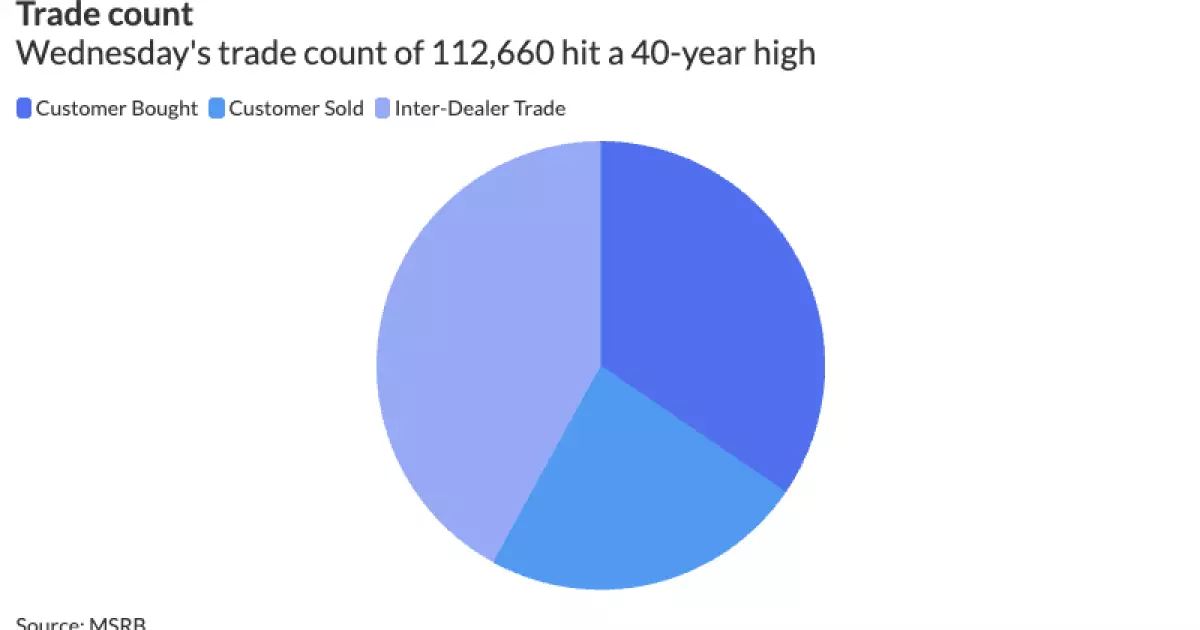The recent bout of volatility in municipal bonds has sent waves through the market, as investors grapple with the implications of President Donald Trump’s 90-day pause on retaliatory tariffs. This sudden change of pace has dramatically affected yield curves, with AAA yields witnessing precipitous drops of 30 to 50 basis points. Such fluctuations evoke memories of previous seismic shifts in the marketplace, notably those seen during the pandemic and in earlier economic crises. The dynamics at play aren’t just numbers on a page; they reflect a broader narrative of economic uncertainty that has gripped investors for years.
What makes this situation especially intriguing is the unprecedented volatility recorded in the history of municipal securities. The three most significant single-session yield adjustments occurred just hours apart last week, reminiscent of the market chaos we faced during the initial waves of COVID-19. Yet, the intensity of these fluctuations signifies more than just market reactions to tariffs; it draws attention to a fragile economy and a populace wary of the future.
The Market’s Panic: Unprecedented Trading Activity
The trading activity during this period has turned the marketplace into a chaotic scene. On Wednesday, the number of trades surged to an astounding 112,600—the highest level seen since 1995, as a staggering $32.5 billion changed hands. This frenzy highlights not only a liquidity crisis but also the palpable fear among investors who struggled to determine their next moves. What is happening behind the scenes suggests an urgent need for clearer guidance and measures to restore confidence within this critical sector.
At the forefront, the chief investment officer at BlackRock illuminated the plight of investors during this time. The inability to buy or sell bonds for consecutive days raises alarming questions about the viability of municipal bond liquidity. When traders are looking to exit positions and are met with barriers, it suggests a systemic issue rather than just momentary market fluctuations. Individuals hoping to capitalize on the market must be particularly cautious, as liquidity constraints can heavily distort asset prices.
A Ray of Hope or a False Dawn? Implications of Trump’s Announcement
President Trump’s announcement of the 90-day extension on tariffs, while initially buoying stocks, has not entirely quelled concerns across the municipal bond marketplace. Some experts argue that this development acted as a double-edged sword. While it may have momentarily soothed market fears, the lingering sentiment of unpredictability persists. Rather than establishing stability, such drastic policy shifts may serve as a constant reminder of the volatility that investors must navigate.
Jeff Timlin of Sage Advisory has indicated that even with the tariff-induced calm, broad-based selling remains evident in the market. This atmosphere creates a complex backdrop, where investors are divided between seizing opportunities and fearing further market disturbances. The underlying trend seems to indicate that even with signs of recovery in yield curves, many investors will likely remain cautious.
The Struggle of Municipal Bonds: Technical Weakness in the Background
Despite the brief rally in confidence, the technical environment for municipal bonds remains bleak. Supply issues dominate the narrative, with robust supply not dramatically alleviating the stress levels felt by investors. Many municipal deals have either been postponed or moved into a day-to-day calendar, muddying the waters of the market even further. Until the supply dynamics stabilize, we are unlikely to witness any lasting strength in munis.
Moreover, experts warn that the anticipated strength associated with increasing redemptions and coupon payments in coming months may not be sufficient to reset the bond market. As such, the prospects for municipal bonds remain tenuous at best. Investors savvy in understanding broader macroeconomic indicators will find themselves better positioned; after all, an evolving economic landscape necessitates a proactive approach.
Navigating Future Risks: The Importance of Strategic Planning
In light of current market turbulence, investors must adopt a strategic mindset rather than succumb to the chaos. Focusing on durable assets within the AAA and AA categories appears wise, as they may offer more security during times of uncertainty. The ability to discern quality amidst market noise can provide investors with a much-needed edge, and the divergence between lower-rated bonds and the higher-rated classes presents a unique opportunity.
Staying abreast of economic indicators, political maneuvers, and global market trends will be fundamental in shaping future investment decisions. The bond market is a reflection of society’s economic psyche, and in today’s fast-moving world, understanding the underlying currents is essential for capitalizing on growth opportunities.
The road ahead may be fraught with challenges, but within these challenges lie lessons and prospects that savvy investors can exploit for future gain. Ultimately, success in the bond market does not solely depend on reacting to current events; it requires foresight, strategic thought, and a commitment to viewing the market through a discerning lens.

